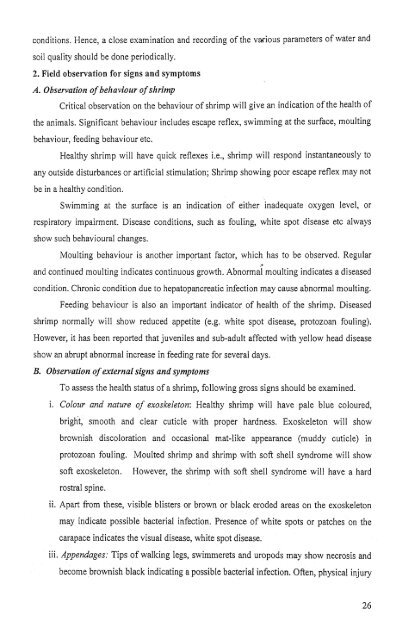, Diagnosis an-&& of Shrimp Diseases - Central Institute of ...
, Diagnosis an-&& of Shrimp Diseases - Central Institute of ...
, Diagnosis an-&& of Shrimp Diseases - Central Institute of ...
- No tags were found...
Create successful ePaper yourself
Turn your PDF publications into a flip-book with our unique Google optimized e-Paper software.
conditions. Hence, a close examination <strong>an</strong>d recording <strong>of</strong> the various parameters <strong>of</strong> water <strong>an</strong>dsoil quality should be done periodically.2. Field observation for signs <strong>an</strong>d synlptomsA. Observation <strong>of</strong> beltaviorar <strong>of</strong> shrimpCritical observation on the behaviour <strong>of</strong> shrimp will give <strong>an</strong> indication <strong>of</strong> the health <strong>of</strong>the <strong>an</strong>imals. Signific<strong>an</strong>t behaviour includes escape reflex, swimming at the surface, moultingbehaviour, feeding behaviour etc.Healthy shrimp will have quick reflexes i.e., shrimp will respond inst<strong>an</strong>t<strong>an</strong>eously to<strong>an</strong>y outside disturb<strong>an</strong>ces or artificial stimulation; <strong>Shrimp</strong> showing poor escape reflex may notbe in a healthy condition.Swimming at the surface is <strong>an</strong> indication <strong>of</strong> either inadequate oxygen level, orrespiratory impairment. Disease conditions, such as fouling, white spot disease etc alwaysshow such behavioural ch<strong>an</strong>ges.Moulting behaviour is <strong>an</strong>other import<strong>an</strong>t factor, which has to be observed. Regular<strong>an</strong>d continued moulting indicates continuous growth. Abnormal moulting indicates a diseasedcondition. Chronic condition due to hepatop<strong>an</strong>creatic infection may cause abnormal moulting.Feeding behaviour is also <strong>an</strong> import<strong>an</strong>t indicator <strong>of</strong> health <strong>of</strong> the shrimp. Diseasedshrimp normally will show reduced appetite (e.g. white spot disease, protozo<strong>an</strong> fouling).However, it has been reported that juveniles <strong>an</strong>d sub-adult affected with yellow head diseaseshow <strong>an</strong> abrupt abnormal increase in feeding rate for several days.B. Observation <strong>of</strong> external signs <strong>an</strong>d symptomsTo assess the health status <strong>of</strong> a shrimp, following gross signs should be examined.i. Colour <strong>an</strong>d nature <strong>of</strong> exoskeleton: Healthy shrimp will have pale blue coloured,bright, smooth <strong>an</strong>d clear cuticle with proper hardness. Exoskeleton will showbrownish discoloration <strong>an</strong>d occasional mat-like appear<strong>an</strong>ce (muddy cuticle) inprotozo<strong>an</strong> fouling. Moulted shrimp <strong>an</strong>d shrimp with s<strong>of</strong>t shell syndrome will shows<strong>of</strong>t exoskeleton. However, the shrimp with s<strong>of</strong>t shell syndrome will have a hardrostra1 spine.ii. Apart from these, visible blisters or brown or black eroded areas on the exoskeletonmay indicate possible bacterial infection. Presence <strong>of</strong> white spots or patches on thecarapace indicates the visual disease, white spot disease.iii. Appendages: Tips <strong>of</strong> walking legs, swimmerets <strong>an</strong>d uropods may show necrosis <strong>an</strong>dbecome brownish black indicating a possible bacterial infection. Often, physical injury
















